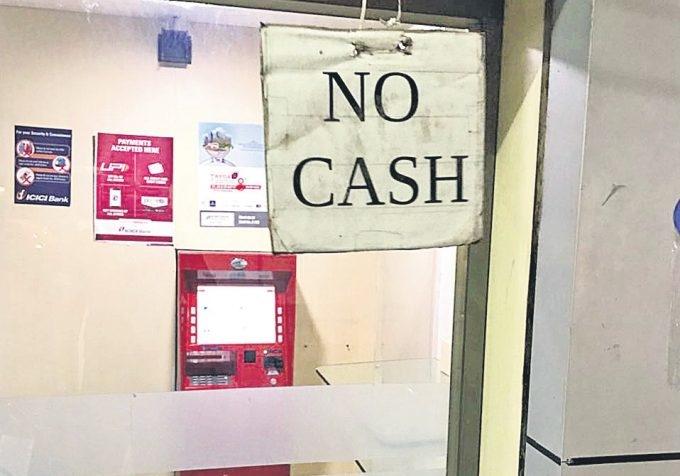Demon Fears Return as Govt. Cash Policy Flounders

People thought that the nightmare of notebandi(demonetization) was finished and buried forever. But mismanagement of currency supply and, more importantly, the dominance of big denomination (Rs.2000) notes has again created similar conditions. In a swathe of states - Karnataka, Maharashtra, Andhra Pradesh, Gujarat, Rajasthan, Uttar Pradesh, Madhya Pradesh, Chhattisgarh, at last count – people were facing empty ATMs sparking near panic. The situation has been steadily worsening for nearly two weeks and anger is mounting.
According to RBI, value of notes in circulation was Rs. 17,741.87 billion on 4 November 2016, just before 86% of the currency was suddenly demonetized on 8 November 2016 by Prime Minister NarendraModi. One and half years later, RBI says notes in circulation on 6 April 2018 were valued at Rs.18,169.23 billion. So, more notes are in circulation technically. Then why the cash crunch?
There seem to be two reasons: mismanagement of currency note distribution and a deep flaw in the post-demon currency policy.
SP Shukla, Union Minister of State for Finance, told ANI that some states have less currency and others have more. This means that distribution of notes to various RBI centres is uneven and so there are periodic shortages in some places. When this happens, RBI scrambles to shift more cash to the affected area. Or so the narrative goes.
In a written reply to a question(#4829) raised in the LokSabha on 23 March, Shukla gave details of how much currency was given to which of the 19 RBI offices in the country. Between 1 April 2017 and 28 February 2018, Jaipur (Rajasthan) got Rs.23,654crore, Bhopal got Rs.38,884, Bhubaneswar got Rs.21,192 crore while Hyderabad got Rs.54,337 crore, Ahmedabad got Rs.40,954 crore, Nagpur got Rs.40,047 crore. Clearly, some centres were getting more and some less for reasons not mentioned.
But there is more to this than just administrative issues as the minister is suggesting while bunting the ball firmly into RBI’s court.
Consider this: big notes have less speed of movement, and tend to sink to the bottom often in invisible holes. India has a huge population of poor people whose daily transactions involve just a few rupees. Big denomination notes like the erstwhile Rs.1000 note and even more so, the current Rs.2000 notes do not have much scope of repeated transactional speed. They may move better in urban middle class settings but in the vast hinterland it is difficult to get change for a Rs.2000 note in normal times. Since there is no intermediary note between Rs.2000 and Rs.500, changing the Rs.2000 note has been very difficult for people. If you buy something for say Rs.500, rarely will anybody give back three Rs.500 notes. On the other hand, the Rs.2000 notes are convenient for cash hoards, black money transactions or holdings.
Figures for how many Rs.2000 notes and lower denomination notes are in circulation are available only for March 2017. According to these figures, put out by RBI, just over 50% of the currency in circulation at that time was in Rs.2000 notes. Rs.500 notes accounted for another big chunk – 22.5%. The balance of 27.5% currency was in smaller denominations, mainly Rs.100.
Compare this distribution to pre-demon days. In March 2016, there were no Rs.2000 notes but 38.6% notes were in Rs.1000 denomination and a whopping 47.8% were in Rs.500 notes.
The shift from lower to higher denomination notes is clear. Since March 2017 the situation may have changed but how much?
This is the real root of the problem that people are facing today. The govt. has been focusing on printing and issuing large denomination notes, perhaps to rapidly compensate for the withdrawal of currency by notebandi, but more likely also to push people to go cashless – another one of Modi’s pipe dreams. So, the economy has become flush with big notes. These are virtually unusable by a large majority of the population and are probably being used for all kinds of underhand black money transactions. Hence the cash crunch for common people.
Other contributory factors include fears of the FRDI Bill, which is perceived as threatening bank deposits, causing people to hoard cash, increased demand in the harvest season when a lot of transactions take place, and spurt in demand for the recent festive season.
But one fact is inescapable: Modi govt. is either completely inept or it is brazenly foisting a cash crisis in pursuit of forcing people into cashless payments.
Get the latest reports & analysis with people's perspective on Protests, movements & deep analytical videos, discussions of the current affairs in your Telegram app. Subscribe to NewsClick's Telegram channel & get Real-Time updates on stories, as they get published on our website.
























